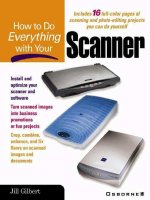How to Do Everything With Your Scanner- P16 ppt
Bạn đang xem bản rút gọn của tài liệu. Xem và tải ngay bản đầy đủ của tài liệu tại đây (234.96 KB, 5 trang )
FIGURE 3-5
The Hewlett-Packard website
FIGURE 3-6
The Visioneer website
Link to
customer
service
Link to
technical
support
CHAPTER 3: Selecting the Right Scanner
59
3
Please purchase PDF Split-Merge on www.verypdf.com to remove this watermark.
For example, as of the writing of this book, I found a scanner with 600×1200 dpi
optical resolution and a 30-bit depth for only $50.
The Overstock.com site, shown in Figure 3-7, offers good service as well. You
have access to customer support, both by telephone and email. There’s also a fairly
liberal return policy.
FIGURE 3-7
The Overstock.com website is for bargain hunters.
60
How to Do Everything with Your Scanner
Please purchase PDF Split-Merge on www.verypdf.com to remove this watermark.
Precaution: Check the Service Record of the
Online Vendor
When shopping on line, you can find out about the service and privacy reputation of
the online vendor. The Gomez.com website, at www.gomez.com, shown in Figure 3-8,
provides a consumer rating service for online vendors. The supplier sites are evaluated
based on customer support and service, reliability, and adherence to privacy standards
for your credit-card information.
FIGURE 3-8
Gomez rates online computer vendors for consumers.
CHAPTER 3: Selecting the Right Scanner
61
3
Please purchase PDF Split-Merge on www.verypdf.com to remove this watermark.
Gomez also certifies online vendors that meet the minimum performance stan-
dards it has set, as shown in Figure 3-8.
Buying a Scanner in Person
After you’ve exhausted the Internet resources in your scanner search, you’re faced
with the decision of whether go one step further and order your scanner with a click
of your mouse. It’s certainly convenient to do so, but actually visiting an office
equipment store and making your purchase in person offers several advantages:
Savings on shipping costs Most vendors charge separately for shipping, so you
have to factor in the added cost when comparison-shopping. Overnight or next-day
freight can be downright pricey—as much as $30.00.
Ease of testing This is a definite advantage, and you should be prepared to avail
yourself of it by bringing a few photos.
Immediate delivery No waiting for the delivery. You can drive off with your
new purchase in your trunk.
Returns are easier Most people are more comfortable taking a defective
product back to the store for immediate credit rather than shipping it back and
waiting for credit.
Narrowing Down the Choices
This chapter helped you assess your scanning needs and identify the features in a
scanner that might help you accomplish them. You also learned which scanner infor-
mation and specifications to compare, and some websites that can save you research
time in doing so. You even learned how to test a sample scanner in the store, and
where to go on the Web to look for a bargain if you choose to order one on line. The
next chapter helps you become familiar with the operation of your scanner once
you’ve purchased it.
62
How to Do Everything with Your Scanner
Please purchase PDF Split-Merge on www.verypdf.com to remove this watermark.
Test a Scanner
Many of the larger office equipment and supply stores have scanners on their
sales floor that they invite you to test before making a purchase. Usually, the
manufacturer provides a test shot for you to scan, but I suggest you bring your
own photo.
Select a test shot with people in it. Skin tones are hardest to replicate
accurately. Scanning skin tones allows you to see the relative color depth
capacities of different scanners, since a hint of green or a yellow tinge on a
person’s face is pretty noticeable.
You should also look at the light and dark areas of the picture. Do these areas
retain their detail, or do they appear to be a single shade? Generally, the higher
the color depth, the more detail you retain in the light and dark areas of the
photo.
Scanner speed is another issue. Speed specifications usually aren’t provided
by the manufacturer. Store testing allows you the opportunity to pit two scanners
on your short list in an actual race to see which offers you a faster scan.
Some Scanners Have Memory Card
Readers for Digital Camera Photos
Have you ever thought, “Wouldn’t it be great if I had a single way to get
my scanned and digital camera photos into the computer?” One leading
manufacturer, Visioneer, has recently introduced the first scanner with built-in
CompactFlash and SmartMedia high-speed memory card readers. (A memory
card stores photos from a digital camera or other device and can store a lot
more high-resolution photos than an ordinary floppy disk). The new Visioneer
PhotoPort 7700 USB scanner transfers images up to 40 times faster than serial
Continued on next page
CHAPTER 3: Selecting the Right Scanner
63
3
Please purchase PDF Split-Merge on www.verypdf.com to remove this watermark.









